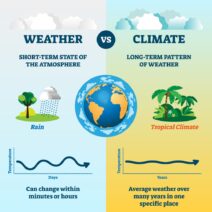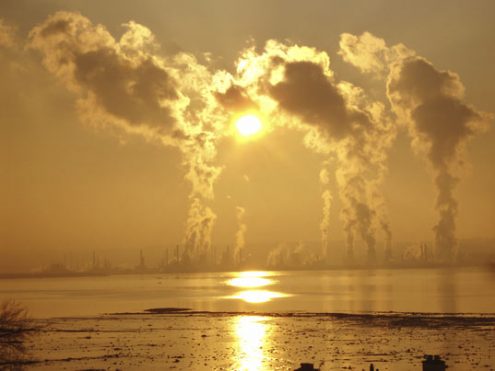Global warming and global dimming present a complex interaction that captivates scientists and environmentalists alike, sparking intrigue and concern. While both phenomena pertain to climate change, they represent divergent aspects of Earth’s atmospheric dynamics, each influencing and counterbalancing the other in intriguing ways. Understanding how these two phenomena interact unveils a deeper narrative about our planet’s climate system and the multifaceted challenges we face in combating climate change.
At the core of this discussion is global warming, characterized by the long-term increase in Earth’s average surface temperature due to heightened concentrations of greenhouse gases such as carbon dioxide, methane, and nitrous oxide. These gases trap heat in the atmosphere, leading to a variety of deleterious effects including melting polar ice caps, rising sea levels, and extreme weather events. The ramifications of global warming are tangible and dire, reflected in shifting ecosystems and the displacement of communities across the globe.
Conversely, global dimming refers to the phenomenon whereby the Earth’s surface receives less solar radiation than it did in the past. This reduction in sunlight reaches the Earth due to various factors, prominently including increased atmospheric aerosols. These microscopic particles, primarily from human activities like burning fossil fuels and deforestation, scatter and absorb sunlight, diminishing the amount of solar energy penetrating the atmosphere. As a result, globally, surface temperatures can experience a reduction, which presents an interesting paradox when juxtaposed with global warming.
While it may seem counterintuitive, the dual occurrence of global warming and global dimming underscores the complexity of Earth’s climate system and the intricacies of anthropogenic influences. Global dimming has an interesting effect; it partially masks the intensity of global warming. Essentially, the cooling effect of aerosols can lead to an underestimation of the actual warming that would occur in their absence. This paradox raises a critical question: what might our climate look like if we were to mitigate emissions that contribute to global dimming?
The interaction between these two phenomena becomes even more pronounced when we consider the potential implications of reducing aerosols. Should international efforts to improve air quality lead to significant reductions in aerosol emissions, we could unwittingly unleash the full extent of global warming, resulting in abrupt and severe climate changes. This scenario illustrates the delicate balance that exists within the climate system, where actions taken to alleviate one problem may inadvertently exacerbate another.
Furthermore, studies indicate that global dimming may have also contributed to regional climate anomalies. For example, areas such as North America and Europe have experienced different climatic responses due to the presence of aerosols, creating a disparity between observed temperatures and the underlying warming trend. This interaction complicates climate models and hinders our ability to accurately predict future climate scenarios.
The question of whether global dimming can act as a buffer against global warming poses a fascinating dilemma. While it provides a temporary respite from rising temperatures, the health implications of aerosols are dire. Increased aerosol concentration leads to respiratory disorders and cardiovascular issues, which begs the question of whether the temporary cooling effect is worth the human cost. As awareness of the detrimental health effects of air pollution mounts, there is a growing consensus that strategies to combat climate change must prioritize the reduction of both greenhouse gases and aerosols simultaneously.
Moreover, the intricate interplay between global dimming and global warming highlights the importance of understanding regional climate impacts. Different geographical areas may respond uniquely to fluctuations in aerosol concentrations, making it crucial to develop localized climate strategies rather than relying on broad, one-size-fits-all solutions. Climate change is not merely a global issue; its impacts reverberate through local environments, economies, and societies.
As research advances, there is a need for a paradigm shift in how we perceive global dimming and global warming. Historically, efforts to combat climate change have primarily focused on reducing greenhouse gas emissions. However, the recognition of aerosols as a significant factor within this equation necessitates a more holistic approach. Policymakers must integrate strategies aimed at both aerosol reduction and greenhouse gas mitigation to effectively address the intertwined challenges of climate change.
Education and advocacy play pivotal roles in promoting understanding of the climate paradox. Raising awareness about the interactions between global dimming and global warming not only fosters informed public discourse but also galvanizes action. Communities, industries, and governments must collaborate to adopt sustainable practices that will inevitably reduce greenhouse gas emissions while mitigating harmful aerosols.
Ultimately, the relationship between global dimming and global warming is a vivid illustration of the complexities that characterize our climate system. As we navigate through these challenges, a nuanced comprehension of these interactions is essential. Humanity’s actions on one front can reverberate into another, thus necessitating an integrated approach to tackling climate change. The climate paradox reminds us that while the pursuit of global cooling may seem desirable, sustainable progress must not come at the expense of human health or ecological integrity.
In conclusion, the intricate interplay between global dimming and global warming encapsulates the paradoxical nature of our climate crisis. Unraveling this connection reveals not only the inherent complexities of the climate system but also the urgent need for comprehensive strategies that address both phenomena. As we confront one of the most pressing challenges of our time, the path forward requires a keen understanding of the intricate dance between warming and dimming, guiding us toward a balanced and sustainable future.







